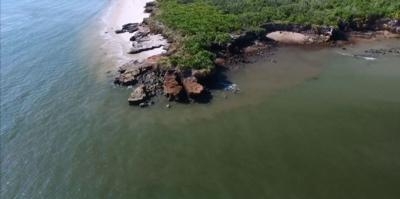Two Vehicles Worked In Concert For Study Of The Ecosystem
On June 19, scientists and technology companies partnered with the Florida Department of Environmental Protection (FDEP) to passively survey the Nassau Sound Aquatic Preservation Area, situated at the oceanic coastal border between Florida and Georgia. Roveal Underwater Robotics, in collaboration with Aviation Systems Engineering Company (ASEC), teamed to achieve history by deploying an undersea robot while simultaneously flying a drone in mutually supporting roles, the first time ever in Florida in support of the scientific community. This approach successfully proved to be a new scientific method for safe, effective, and innovative observational exploration by capturing undersea and aerial HD video to be distributed and shared with scientists and governmental agencies.

Roveal technicians navigated their tethered, remotely operated underwater vehicle, or ROV, equipped with a HD camera to provide undersea streaming video to a monitor located onboard its floating research vessel. The research team coordinated via radio with the nearby ASEC crew, who piloted their FAA-approved drone to scout and survey areas from above, also streaming HD video. Research team member Bill Andersen, a native Floridian biologist with over 50 years of diving experience in Florida waters, remarked, “This project demonstrated a new tool for scientists to search for the invasive Lion Fish and the rare Atlantic Sturgeon in ways never before considered. I’m extremely excited by the possibilities for how this technology can benefit our aquatic and marine ecosystems.”
Also participating in the project was Andrea Noel Small, the FDEP Manager for Northeast Florida Aquatic Preserve. Having FDEP support was particularly important to ensure the project aligned with their stated mission to protect, conserve and manage Florida’s natural resources. Since this was the first time a robot was used by FDEP, and the first time a ROV and drone were used in tandem, not only was it critical to build a professional and safe team, but one that complied with local, state and federal laws. Some of the data points collected included information on native grass beds, oyster beds, vertebrate marine life, water column temperature readings, presence of halocline, and channel depth soundings. The project achieved success in all these areas while developing baseline data for future, comparative analysis for Andrea and her scientists.
Perhaps the highlight of the day for the research team was the opportunity to meet with the young men from Jacksonville-based, Safe Harbor Maritime Academy who visited the research projects day long effort. Roveal Robotics CEO Justin Dee provided an educational, hands-on ROV piloting experience for young men and discussed career opportunities. Similarly, ASEC’s Brent Klavon explained drone technology and its impact on the aviation industry. The innovative research project, along with the visit from Safe Harbor, provided an example for how government, academia, and industry can collaborate to insure future Floridians will have healthy aquatic and marine ecosystems.
(Image provided by ASEC)
 ANN's Daily Aero-Linx (05.02.24)
ANN's Daily Aero-Linx (05.02.24) ANN's Daily Aero-Term (05.02.24): Touchdown Zone Lighting
ANN's Daily Aero-Term (05.02.24): Touchdown Zone Lighting Aero-News: Quote of the Day (05.02.24)
Aero-News: Quote of the Day (05.02.24) ANN FAQ: Contributing To Aero-TV
ANN FAQ: Contributing To Aero-TV NTSB Final Report: Cirrus Design Corp SR20
NTSB Final Report: Cirrus Design Corp SR20



